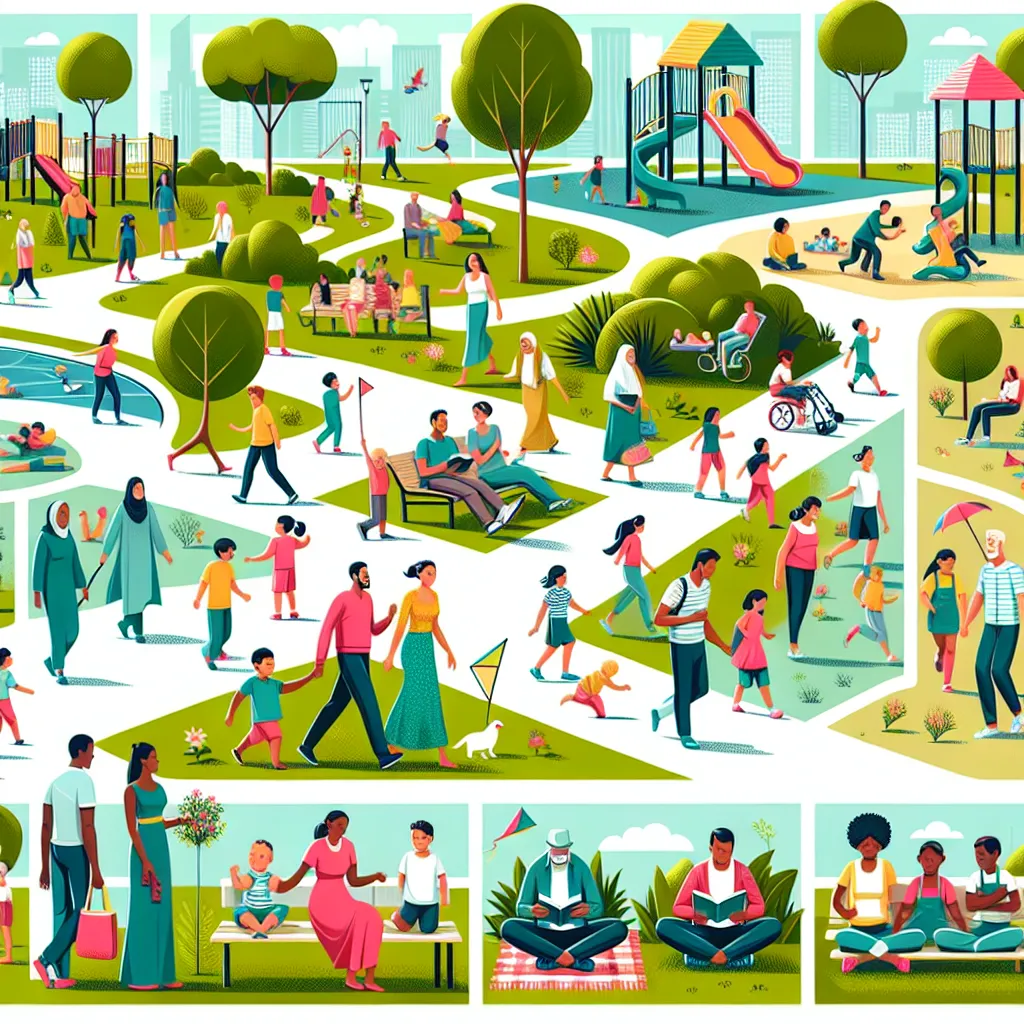Public parks and recreational areas are common topics in IELTS Speaking tests, particularly in Part 2. This subject allows examiners to assess your ability to describe places, express personal opinions, and discuss environmental and social issues. Understanding how to effectively answer questions about public spaces can significantly boost your IELTS Speaking score.
Nội dung bài viết
- Part 1: Introduction and Interview
- Q: Do you often go to parks?
- Q: What do you usually do when you’re at a park?
- Part 2: Long Turn (Cue Card)
- Additional questions the examiner might ask:
- Part 3: Two-way Discussion
- Q: What are the benefits of having public parks in cities?
- Q: Do you think governments should invest more in public recreational areas?
- Key Vocabulary and Phrases for High Scores
- Examiner’s Advice
 IELTS Speaking Public Park
IELTS Speaking Public Park
Part 1: Introduction and Interview
In Part 1, the examiner may ask general questions about parks and recreational areas. Here are some possible questions with sample answers:
Q: Do you often go to parks?
Band 6-7 Answer:
Yes, I do. I try to visit the park near my house at least once a week. It’s a nice place to relax and get some fresh air.
Band 8-9 Answer:
Absolutely! I make it a point to frequent the local park in my neighborhood at least twice a week. It’s not just a place for relaxation, but also serves as my go-to spot for rejuvenation and connecting with nature amidst the urban hustle and bustle.
Q: What do you usually do when you’re at a park?
Band 6-7 Answer:
When I’m at the park, I usually go for a walk or jog. Sometimes, I also like to sit on a bench and read a book or just enjoy the scenery.
Band 8-9 Answer:
My activities at the park are quite diverse. On most visits, I engage in a brisk walk or jog to maintain my fitness. However, I also relish the opportunity to find a quiet spot where I can immerse myself in a good book or simply bask in the natural surroundings, allowing the peaceful atmosphere to rejuvenate my mind and body.
Part 2: Long Turn (Cue Card)
Now, let’s focus on a cue card related to describing a public park or recreational area:
Describe a public park or recreational area in your town
You should say:
- Where it is located
- What features or facilities it has
- What people usually do there
- And explain why you like or dislike this place
Band 6-7 Sample Answer:
I’d like to talk about Central Park, which is located in the heart of my city. It’s quite large and easy to access from different parts of town.
The park has many features that make it popular. There are walking paths, a small lake, and several playgrounds for children. There’s also a sports area with tennis courts and a football field. Many people go there to exercise or play sports.
People visit the park for various reasons. Some go for walks or jogs, while others enjoy picnics with their families. On weekends, you can see many children playing in the playgrounds. There are often events held in the park too, like outdoor concerts or markets.
I really like this park because it offers a green space in our busy city. It’s a great place to relax and enjoy nature without having to leave town. The park is well-maintained, which makes it pleasant to visit at any time of the year.
Band 8-9 Sample Answer:
I’d like to elaborate on Central Park, a verdant oasis nestled in the heart of our bustling metropolis. Its strategic location makes it easily accessible from various quarters of the city, serving as a focal point for community gatherings and recreational activities.
The park boasts an impressive array of features that cater to diverse interests. Meandering paths wind through lush greenery, perfect for leisurely strolls or invigorating jogs. A picturesque lake serves as a centerpiece, offering a tranquil spot for contemplation or paddle boating. The park is also dotted with state-of-the-art playgrounds that spark children’s imaginations. For sports enthusiasts, there are well-maintained tennis courts and a spacious football field, fostering a sense of healthy competition and camaraderie.
The park serves as a magnet for people from all walks of life. Fitness aficionados can be seen pounding the pavement at dawn, while families flock to the grassy areas for weekend picnics. The playgrounds buzz with the laughter of children, especially during school holidays. The park also plays host to a variety of events, from open-air concerts that reverberate through the evening air to vibrant markets that showcase local crafts and produce.
What I find particularly appealing about Central Park is its role as a green lung in our concrete jungle. It offers a much-needed respite from the urban grind, allowing city dwellers to reconnect with nature without venturing far from home. The park’s impeccable maintenance ensures a pleasant experience year-round, whether you’re seeking a quiet moment of solitude or a lively social gathering. In essence, it embodies the perfect balance between natural beauty and urban convenience, making it an indispensable part of our city’s landscape.
Additional questions the examiner might ask:
- How often do you visit this park?
- What improvements would you suggest for the park?
Band 6-7 Answer:
I try to visit the park at least once a week, usually on weekends. As for improvements, I think adding more benches and perhaps a café would be nice.
Band 8-9 Answer:
I make it a point to frequent the park at least twice a week, often incorporating it into my daily routine. Regarding potential enhancements, I believe implementing a more diverse range of flora to create seasonal gardens would elevate the park’s aesthetic appeal. Additionally, establishing a cultural corner for outdoor art exhibitions or poetry readings could enrich the park’s role as a community hub.
Part 3: Two-way Discussion
In Part 3, the examiner will ask more abstract questions related to the topic. Here are some possible questions with sample answers:
Q: What are the benefits of having public parks in cities?
Band 6-7 Answer:
Public parks offer many benefits to city dwellers. They provide green spaces for relaxation and exercise, which is important for physical and mental health. Parks also help to reduce pollution and make cities more attractive.
Band 8-9 Answer:
The advantages of incorporating public parks into urban landscapes are manifold. Firstly, they serve as vital green lungs, mitigating air pollution and contributing to the overall environmental health of cities. Moreover, these spaces foster community cohesion by providing venues for social interaction and cultural events. From a health perspective, parks offer accessible areas for physical activity, crucial in combating the sedentary lifestyle often associated with urban living. Additionally, they play a significant role in urban biodiversity, providing habitats for various flora and fauna. Economically, well-maintained parks can enhance property values in surrounding areas and attract tourism, thus contributing to the city’s overall appeal and economic vitality.
Q: Do you think governments should invest more in public recreational areas?
Band 6-7 Answer:
Yes, I believe governments should invest more in public recreational areas. These spaces are important for community well-being and can improve the quality of life in cities. They provide places for people to exercise and socialize, which is especially important in crowded urban areas.
Band 8-9 Answer:
I firmly believe that increased government investment in public recreational areas is not just beneficial, but imperative for modern urban development. Such investments yield multifaceted returns on both societal and individual levels. They contribute significantly to public health by providing accessible spaces for physical activity, thereby potentially reducing healthcare costs in the long run. Moreover, these areas serve as social equalizers, offering recreational opportunities to all segments of society regardless of economic status. From an environmental standpoint, they play a crucial role in maintaining ecological balance within urban settings. Additionally, well-designed public spaces can boost local economies by increasing property values and attracting businesses. In essence, investing in these areas is an investment in the holistic well-being of communities and the sustainable development of cities.
Key Vocabulary and Phrases for High Scores
To elevate your IELTS Speaking performance, incorporate these advanced vocabulary items and phrases:
-
Verdant /ˈvɜːrdənt/ (adjective): Green with grass or other rich vegetation.
Example: The park’s verdant lawns are perfect for picnics. -
Focal point /ˈfoʊkl pɔɪnt/ (noun): The center of interest or activity.
Example: The lake serves as the focal point of the park’s design. -
Meander /miˈændər/ (verb): To follow a winding course.
Example: Paths meander through the park, offering scenic walks. -
Rejuvenate /rɪˈdʒuːvəneɪt/ (verb): To give new energy or vigor to; revitalize.
Example: A walk in the park can rejuvenate both mind and body. -
Biodiversity /ˌbaɪoʊdaɪˈvɜːrsəti/ (noun): The variety of plant and animal life in a particular habitat.
Example: The park’s biodiversity makes it a haven for nature lovers.
Examiner’s Advice
To excel in describing public parks or recreational areas in your IELTS Speaking test:
- Use a variety of descriptive adjectives to paint a vivid picture of the park.
- Discuss both the physical features and the social aspects of the park.
- Include personal anecdotes or observations to make your description more engaging.
- Practice describing different types of parks to expand your vocabulary and ideas.
- Consider the broader impact of parks on communities and the environment for Part 3 discussions.
Remember, the key to a high score is not just in what you say, but how you say it. Aim for fluency, coherence, and a range of vocabulary and grammatical structures in your responses.
For more practice on describing places, you might find it helpful to read about how to describe a place where you go to spend time with your family or how to describe a place where you go to relax and recharge. These resources can provide additional vocabulary and strategies for talking about various locations in your IELTS Speaking test.


